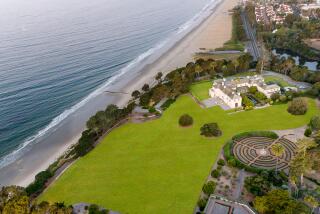Victorian--Piece by Piece : Couple Transform New England Saltbox Into Turreted, Stained-Glass Fantasy Home
- Share via
CORONA DEL MAR — Dick and Jane Croul once lived in a little red New England saltbox on Fernleaf Avenue. Built around 1943 of packing-crate lumber, it was a simple house, one story with a loft and a white picket fence. No frills, minimal landscaping. Sensible. Sedate.
Today, after an almost eerie series of serendipitous events, that saltbox is a four-bedroom, geranium-draped Victorian fantasy complete with a 19th-Century turret, stained-glass windows, wrought-iron fence and white gingerbread.
And much of the renovation was free.
It all started with a family ski trip to Aspen in 1969. At that time, the Crouls were already thinking of remodeling the small Corona del Mar house in which they’d lived for 10 years.
Dick, then a building contractor and former Irvine Ranch cowboy who herded cattle across once-open plains, was contemplating a Spanish Colonial design. Jane liked that idea, too. But after seeing the Victorian architecture of Aspen, they had second thoughts. Victorian was charming, they agreed. Funky, different.
“It was actually one of our (three) daughters who first said, ‘Let’s not go Spanish; everyone’s doing it,’ ” Dick said. “She said, ‘How about building one of these crazy houses like here?’ We kind of brushed it aside, but started thinking about it.”
Dick “likes a challenge,” said Jane. “At first he thought it was impossible, but then he thought, well, maybe. . . .”
When they returned home to Corona del Mar, Jane took Dick to Santa Ana to see the French House, an 1871 landmark that then stood behind what was once Buffums department store at Spurgeon and 9th streets.
The Victorian house had long been abandoned, and most of the easily removed parts such as windows and fixtures had been stolen or sold at an estate sale, the Crouls said.
But the solid redwood structure with 100 years’ worth of peeling paint was still standing, along with its turret, corbels, pediments and much of its other decorative gingerbread.
When the Crouls pulled up to the grand old house, they saw a bush burning in the front yard.
“It was prophetic,” said Jane, laughing. “We stopped, got out of the car and stomped out the fire. Seeing this, a neighbor came out and told us the house was being torn down for a Buffums’ parking lot.”
Dick wanted the century-old turret for his own home, so he called Buffums, owner of the house, and negotiated its purchase for $100.
“A lot of people had complained about the house being torn down,” he said. “So Buffums thought it was nice that someone got one of the pieces.”
To prepare for the turret around which the house would be designed, Dick and two of his superintendents tore off the front of the Corona del Mar saltbox and extended the existing structure out nine feet on the 30-foot lot. When the rough framing was completed, the men drove to Santa Ana to get the turret.
Things didn’t go as planned on that hot Friday afternoon.
“I had three ropes on the turret so that when it came off I could load it a certain way,” Dick said. “But one of the ropes broke, and it swung off all at once and ended up backward in the truck.”
Undaunted, the men started the drive home. As they pulled up to a stoplight, the turret’s mullions broke, Dick said.
Two tow trucks and a traffic jam later, the turret finally arrived in Corona del Mar in three pieces.
In the midst of the construction, the Crouls learned that there was an estate sale of all interior parts at the Burns House, a 1907 Victorian next to the French House.
They purchased a light fixture, a chain-pull toilet, eight small ceiling lights, a chandelier and stair railing. The light fixture went into the hallway, and the living room ceiling was reworked to replicate the coffered Burns’ ceiling so that the chandelier and eight lights could be installed. The antique wood toilet went into the downstairs bathroom, and the stair railings went into the turret’s stairwell.
Next, Dick found out when the French House was scheduled to be demolished. On that day, he returned with his truck.
As the structure came down, Dick started pulling off parts with a crowbar, including doors, pediments, posts, front railings and all the other decorative gingerbread he could find to add to his house.
The old porch railings were turned upside down and used as a decorative canopy over the front door. Eyebrows over windows were created using old corbels.
French House posts were used in the Croul upstairs balcony, topped by gingerbread. Old triangular pediments with colored-glass windows were placed on the front and both sides of the house. And heart-shaped pickets from old banister railings were attached to the front of the new structure as decorative gingerbread.
Now it was time to look for a roof pattern, so the Crouls went driving randomly around Santa Ana to get ideas. They came across signs for an estate sale at the Halladay House, a Victorian built in the late 1880s.
There they purchased an antique dining table with 12 chairs, a set of parlor doors, a fireplace surround, a stained-glass window and a plaster light-fixture medallion.
The old window went into the new kitchen, the parlor doors were cut in half and installed under a kitchen counter (“we didn’t know what else to do with them,” said Dick), and the fireplace surround was transformed into a headboard for the bed in the new upstairs master suite.
The plaster medallion was perfect for the chandelier bought at the Burns House estate sale.
“So much of all of this was pure dumb luck,” Jane said.
And their luck continued.
When the Crouls got the turret, all the glass was missing. The clear glass was easy to replace, but the loss of the original amber, red and blue pieces was mourned.
After a newspaper article about the house appeared, the Crouls got a telephone call from an antique dealer who had purchased colored glass from the French House years before. She sold it to the Crouls for the price that she had paid for it, Dick said.
“The pieces were all marked with Roman numerals,” said Dick. “They just went right in, bam, bam, bam.”
That antique dealer also had the French House combination electric and gas light fixture which was purchased by the Crouls and installed in the turret stairwell.
One elaborately carved newel post for the stairwell was found at the Sawdust Festival and another was purchased at a Hollywood “head shop.”
“We were so lucky to get all those old parts, and Dick created a lot of it himself,” Jane said.


